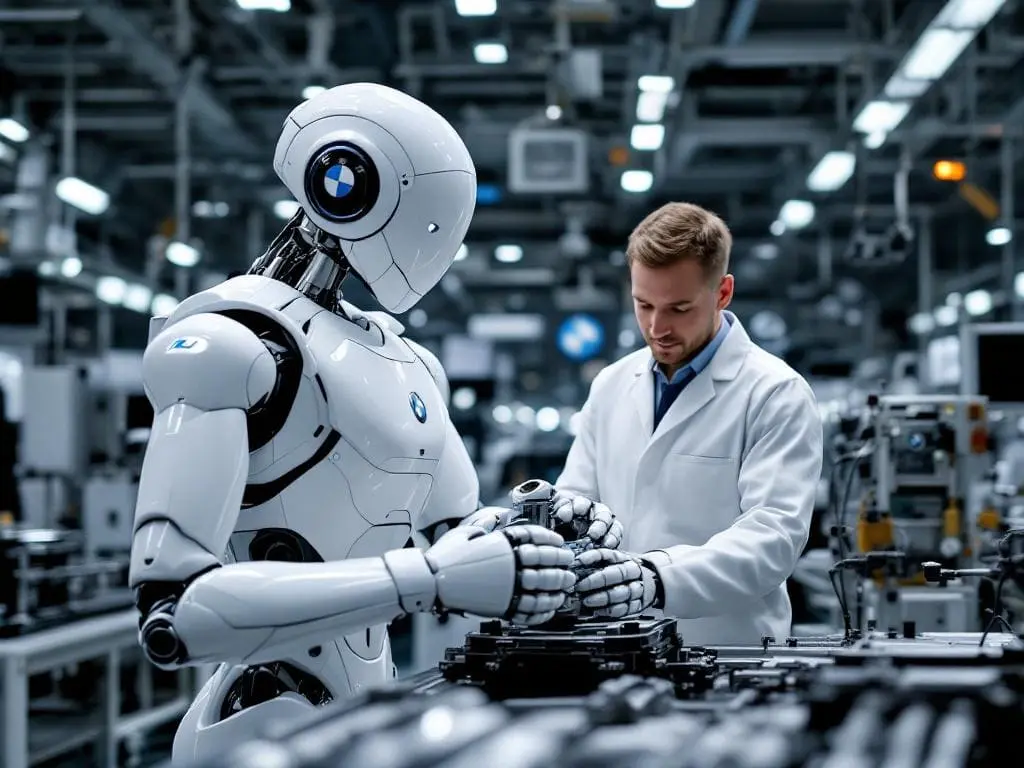
You walk into your favorite coffee shop tomorrow morning, and instead of Jake behind the counter (who always remembers your usual order), you’re greeted by a sleek, human-like robot making your latte with mechanical precision.
Sounds like science fiction?
Well, I have news for you.
Last week, I watched a video of a humanoid robot at BMW’s plant in South Carolina inserting sheet metal parts with millimeter-perfect accuracy.
My first thought wasn’t about the impressive technology, it was about my nephew who just started his first job at a local auto repair shop.
What does his future look like when robots can do his work for 40 cents an hour?
BMW’s Spartanburg plant has just deployed Figure 02 humanoid robots on their production line, and honestly, I can’t stop thinking about what comes next.
These aren’t your typical factory robots bolted to the floor.
These machines can walk, manipulate objects, and perform complex tasks just like humans do.
Here’s what keeps me up at night: Each robot costs $30,000 upfront and operates for roughly 40 cents per hour.
Compare that to minimum wage workers earning $7.25 to $15 per hour, and you start to see why every industry leader is paying attention.
Three Key Takeaways
Before we dive deep, here are the three most important things you need to understand about this robotic revolution:
• Economic disruption is imminent – At 40 cents per hour, these robots will fundamentally change how businesses calculate labor costs across every industry • Job displacement will hit hardest in predictable roles – Fast food, warehousing, and routine manual labor face the biggest immediate threat • Adaptation is our only choice – Workers who upskill and focus on uniquely human capabilities will thrive, while others risk being left behind
The Real Economics Behind Humanoid Robots
Let me break down the numbers that are making CEOs everywhere recalculate their budgets.
| Cost Factor | Human Worker (Min. Wage) | Humanoid Robot |
|---|---|---|
| Initial Investment | $0 | $30,000 |
| Hourly Rate | $7.25 – $15.00 | $0.40 |
| Annual Cost (40 hrs/week) | $15,080 – $31,200 | $832 |
| Benefits & Overhead | $5,000 – $15,000 | $0 |
| Sick Days/Breaks | Unpredictable | Never |
| Total Annual Cost | $20,080 – $46,200 | $6,832 |
When you see it laid out like this, the economics become crystal clear.
A study by McKinsey Global Institute found that automation could displace 375 million workers globally by 2030.
With numbers like these, I understand why.
The robot’s $30,000 price tag gets spread over five years of 24/7 operation.
That’s roughly $300 per month or 40 cents per hour. Meanwhile, human workers need sleep, lunch breaks, vacation time, and health insurance.
How Fast Food Will Never Be the Same
Walk into any McDonald’s during lunch rush, and you’ll see exactly why this industry is ripe for robotic takeover.
The work is repetitive, the turnover is high, and the tasks are surprisingly predictable.
The Current Reality
Fast food restaurants struggle with constant hiring. Employee turnover rates hover around 75% annually, according to the Bureau of Labor Statistics.
Each new hire costs approximately $1,500 to recruit and train.
A typical location employs 15-20 workers across all shifts. At $15 per hour (California’s minimum wage), that’s $468,000 to $624,000 in annual wages alone.
Add benefits, and you’re looking at over $600,000 yearly.
The Robotic Future
Imagine three humanoid robots handling the core operations:
- Robot 1: Takes orders via voice recognition and touch screen
- Robot 2: Prepares food with perfect consistency
- Robot 3: Cleans and restocks continuously
Total annual cost for all three robots: $20,496.
That’s less than what most locations spend on a single human manager.
Major chains are already testing this future. White Castle has deployed robotic fry cooks, and Sweetgreen uses robotic bowl assembly.
The technology exists, it’s just a matter of economics now.
Car Repair Shops Face a Mechanical Revolution
Auto repair might seem like it requires too much skill for robots, but I’ve seen what these machines can do.
The Figure 02 robot can lift 20 kilograms and manipulate tools with human-like dexterity.
Current Labor Challenges
Skilled automotive technicians earn $20-40 per hour, translating to $41,600-$83,200 annually.
Finding qualified mechanics is increasingly difficult, with many shops struggling to fill positions.
Robotic Capabilities
Humanoid robots excel at:
- Oil changes and routine maintenance
- Tire mounting and balancing
- Brake pad replacements
- Engine diagnostics using connected tools
A small shop could deploy two robots for routine work while human technicians handle complex diagnostics and customer interaction.
The robots work nights, weekends, and holidays without overtime pay.
Real-World Impact
Consider Mike’s Auto Repair, a typical three-bay shop. Mike employs four technicians at an average $30 per hour.
His annual labor cost exceeds $240,000. Two humanoid robots could handle 60% of his routine work for under $14,000 annually.
Mike could reduce his staff to two senior technicians while dramatically increasing capacity.
The savings could lower customer prices while improving profit margins.
Warehouse Operations Get a Robotic Upgrade
Amazon and other logistics giants are already testing humanoid robots for good reason.
Warehouses represent the perfect environment for robotic workers.
Current Warehouse Challenges
- High injury rates from repetitive lifting
- Seasonal staffing difficulties
- 24/7 operational demands
- Consistent accuracy requirements
The average warehouse worker earns $15-18 per hour.
A large facility might employ 200-500 workers across all shifts, creating annual labor costs between $6.2 million and $18.7 million.
Robotic Advantages
Research from MIT shows that humanoid robots can perform warehouse tasks with 99.5% accuracy compared to 94% for human workers.
Robots don’t get tired during 12-hour shifts, don’t suffer back injuries from lifting, and work at consistent speeds.
Amazon’s trials with Agility Robotics’ Digit robot demonstrate robots successfully:
- Picking items from shelves
- Packing boxes efficiently
- Moving inventory pallets
- Loading delivery trucks
A 2023 study by Boston Consulting Group found that robotic warehouses could reduce operational costs by 25-30% while improving order accuracy.
White-Collar Jobs Aren’t Safe Either
Here’s where it gets really interesting. While everyone focuses on blue-collar displacement, artificial intelligence combined with humanoid robots threatens knowledge work too.
Vulnerable White-Collar Roles
- Data entry specialists
- Basic bookkeeping
- Customer service representatives
- Insurance claim processors
- Junior financial analysts
The New Reality
A humanoid robot equipped with advanced AI can process documents, answer phone calls, and perform data analysis without breaks or errors.
At 40 cents per hour, robots could replace $50,000-per-year administrative workers.
However, jobs requiring creativity, strategic thinking, and emotional intelligence remain safer.
Leadership roles, creative positions, and complex problem-solving careers will likely see increased demand.
A Personal Story: Sarah’s Coffee Revolution
Let me tell you about Sarah, who owns a small coffee shop in Portland. She employs three baristas at $15 per hour working 40-hour weeks.
Her annual labor cost hits $93,600 before benefits.
Sarah decided to invest in two $30,000 humanoid robots after reading about BMW’s success. Here’s what happened:
The Investment
- Two robots: $60,000 upfront
- Monthly amortization: $1,000 ($12,000 annually)
- Programming and setup: $5,000
- Maintenance budget: $3,000 annually
Total first-year cost: $80,000
The Results
The robots handle:
- Order taking with perfect accuracy
- Consistent latte art and drink preparation
- Continuous cleaning and restocking
- Inventory tracking and reporting
The Human Impact
Sarah kept one experienced barista as a “robot supervisor” and customer relations specialist.
The other two workers had to find new jobs. Customer satisfaction actually increased due to consistent quality and faster service.
Sarah’s annual savings: Over $60,000 after the first year, with even greater savings in subsequent years.
Industry-Specific Transformation Patterns
Manufacturing Expansion
BMW’s success will likely accelerate adoption across automotive and other manufacturing sectors. Ford, General Motors, and Tesla are all evaluating similar programs.
Retail Revolution
Major retailers are testing robots for:
- Stock replenishment
- Price checking and updates
- Customer assistance
- Inventory management
Healthcare Support
Hospitals are exploring robots for:
- Patient room cleaning
- Medication delivery
- Medical supply management
- Basic patient monitoring
Construction Potential
While more challenging, construction robots could handle:
- Material moving and positioning
- Repetitive assembly tasks
- Site cleanup and organization
- Tool and equipment management
The Broader Economic Implications
Productivity Gains
The International Federation of Robotics projects that humanoid robots could increase industrial productivity by 30-50% over the next decade.
This massive efficiency boost could drive economic growth and lower consumer prices.
Employment Displacement Timeline
Research from Oxford Economics suggests:
- 2025-2027: Early adopters in controlled environments
- 2028-2030: Rapid expansion in suitable industries
- 2031-2035: Widespread deployment across sectors
- 2036+: Advanced AI enables complex task automation
Geographic Impact
Manufacturing regions like the Midwest could see the fastest adoption, while service-heavy coastal economies might experience delayed but significant disruption.
Preparing for the Robotic Workforce
Essential Human Skills
The skills that will remain valuable include:
- Creative problem-solving
- Emotional intelligence and empathy
- Complex communication and negotiation
- Strategic thinking and planning
- Adaptability and continuous learning
Retraining Imperatives
Workers in at-risk roles should consider:
- Technology management and programming
- Robot maintenance and repair
- Customer relationship management
- Creative and design fields
- Healthcare and personal services
Educational System Changes
Schools must emphasize:
- STEM education with robotics focus
- Critical thinking and creativity
- Human-robot collaboration skills
- Lifelong learning mindsets
Government and Policy Considerations
Potential Policy Responses
- Universal Basic Income pilot programs
- Massive retraining initiatives
- Robot taxation to fund displaced worker support
- Gradual implementation requirements
- Worker protection legislation
International Competition
Countries that successfully manage this transition will gain significant economic advantages.
China, Japan, and Germany are already investing heavily in humanoid robotics development and deployment strategies.
Technical Challenges and Limitations
Current Robot Limitations
Despite impressive capabilities, humanoid robots still struggle with:
- Unpredictable environments
- Complex decision-making
- Nuanced human interaction
- Creative problem-solving
- Maintenance and self-repair
Safety Considerations
Working alongside humans requires sophisticated safety systems. Robots must detect and respond to human presence, avoiding accidents while maintaining productivity.
Reliability Concerns
Industrial environments demand consistent performance.
Robot downtime could halt entire operations, making reliability crucial for widespread adoption.
Success Stories and Early Adoption
BMW’s Spartanburg Results
Initial reports show:
- 15% increase in production efficiency
- 40% reduction in quality defects
- Improved worker safety metrics
- Lower operational costs
Other Industry Pioneers
- Amazon: Deploying warehouse robots across facilities
- Tesla: Expanding robotic assembly capabilities
- Walmart: Testing store restocking robots
- McDonald’s: Piloting automated food preparation
The Social and Ethical Dimensions
Community Impact
Small towns dependent on manufacturing or service jobs face particular challenges.
Entire communities could see their primary employment base disappear within a decade.
Inequality Concerns
Robotic automation might benefit capital owners while displacing workers, potentially increasing wealth inequality.
Addressing this challenge requires proactive policy intervention.
Psychological Effects
Work provides identity and purpose for many people. Mass unemployment could create significant mental health and social stability challenges.
Investment and Market Opportunities
Robotics Companies to Watch
- Figure AI (BMW’s partner)
- Agility Robotics (Amazon trials)
- Boston Dynamics (advanced mobility)
- Tesla (humanoid development)
- Honda (ASIMO evolution)
Supporting Industries
Growth opportunities exist in:
- Robot maintenance and repair services
- Programming and customization
- Safety equipment and protocols
- Training and education services
- Human-robot interface design
Real Estate Implications
Warehouse and manufacturing facility designs will evolve to optimize robot efficiency rather than human comfort.
This could reshape industrial real estate markets.
Global Competition and Innovation
Leading Countries
- United States: Strong in AI and software
- Japan: Advanced humanoid development
- China: Massive manufacturing applications
- Germany: Industrial automation expertise
- South Korea: Consumer robotics innovation
Technology Transfer
Countries that fall behind in robotics adoption risk becoming economically disadvantaged.
Technology transfer and knowledge sharing become critical competitive factors.
Looking Ahead: The Next Five Years
2025 Predictions
- Major manufacturers begin pilot programs
- Fast food chains test robotic workers
- Warehouse automation accelerates rapidly
- Public awareness and concern increase
2027 Projections
- Cost drops to $20,000 per robot
- Capabilities expand significantly
- First mass layoffs due to automation
- Government intervention discussions begin
2030 Outlook
- Humanoid robots become commonplace
- New economic models emerge
- Society adapts to robot-human workplaces
- Next-generation robots enter development
Final Thoughts
Standing in BMW’s Spartanburg plant, watching robots work alongside humans with seamless precision, I realized we’re witnessing history.
This is the beginning of a fundamental shift in how work gets done.
The $30,000 price tag and 40-cent hourly cost make these robots economically irresistible for many businesses.
Fast food restaurants, auto repair shops, warehouses, and even office buildings will never be the same.
The transformation is coming whether we’re ready or not.
But here’s what gives me hope: Every technological revolution has created new opportunities alongside the disruption.
The printing press eliminated scribes but created publishers, editors, and authors. The internet destroyed traditional retail but birthed e-commerce, digital marketing, and app development.
Our challenge isn’t to stop this change, but it’s to shape it responsibly. We need massive retraining programs, social safety nets for displaced workers, and education systems that prepare people for human-robot collaboration.
Most importantly, we need leaders who understand that technology should serve humanity, not replace it entirely.
The robots are coming to work. The question isn’t whether they’ll arrive, but whether we’ll be ready when they do.
The choices we make in the next few years will determine if this transformation lifts everyone up or leaves millions behind.
What role will you play in this robotic revolution?
Sources
- McKinsey Global Institute. (2024). “The Future of Work in America: People and Places, Today and Tomorrow.” McKinsey & Company Research.
- Oxford Economics. (2023). “How Robots Change the World: Automation’s Impact on Productivity and Jobs.” Oxford Economics Global Research.
- Boston Consulting Group. (2023). “The Rise of Robotics in Logistics: Transforming Warehouse Operations.” BCG Industry Analysis.
- Bureau of Labor Statistics. (2024). “Employment Projections and Automation Impact Analysis.” U.S. Department of Labor Statistics.






